ASUS Z97-Pro WiFi AC Review
by Ian Cutress on July 16, 2014 10:00 AM EST- Posted in
- Motherboards
- Asus
- Haswell
- 802.11ac
- Z97
CPU Benchmarks
Readers of our motherboard review section will have noted the trend in modern motherboards to implement a form of MultiCore Enhancement / Acceleration / Turbo (read our report here) on their motherboards. This does several things – better benchmark results at stock settings (not entirely needed if overclocking is an end-user goal), at the expense of heat and temperature, but also gives in essence an automatic overclock which may be against what the user wants. Our testing methodology is ‘out-of-the-box’, with the latest public BIOS installed and XMP enabled, and thus subject to the whims of this feature. It is ultimately up to the motherboard manufacturer to take this risk – and manufacturers taking risks in the setup is something they do on every product (think C-state settings, USB priority, DPC Latency / monitoring priority, memory subtimings at JEDEC). Processor speed change is part of that risk which is clearly visible, and ultimately if no overclocking is planned, some motherboards will affect how fast that shiny new processor goes and can be an important factor in the purchase.
Compression – WinRAR 5.0.1: link
Our WinRAR test from 2013 is updated to the latest version of WinRAR at the start of 2014. We compress a set of 2867 files across 320 folders totaling 1.52 GB in size – 95% of these files are small typical website files, and the rest (90% of the size) are small 30 second 720p videos.

Image Manipulation – FastStone Image Viewer 4.9: link
Similarly to WinRAR, the FastStone test us updated for 2014 to the latest version. FastStone is the program I use to perform quick or bulk actions on images, such as resizing, adjusting for color and cropping. In our test we take a series of 170 images in various sizes and formats and convert them all into 640x480 .gif files, maintaining the aspect ratio. FastStone does not use multithreading for this test, and thus single threaded performance is often the winner.
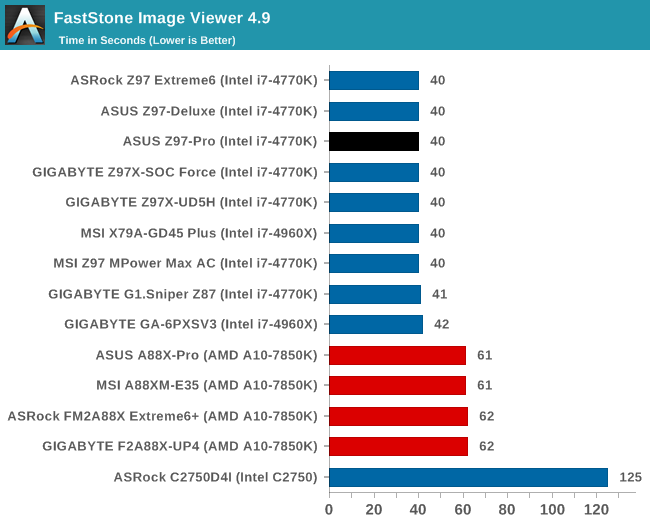
Video Conversion – Xilisoft Video Converter 7: link
The XVC test I normally do is updated to the full version of the software, and this time a different test as well. Here we take two different videos: a double UHD (3840x4320) clip of 10 minutes and a 640x266 DVD rip of a 2h20 film and convert both to iPod suitable formats. The reasoning here is simple – when frames are small enough to fit into memory, the algorithm has more chance to apply work between threads and process the video quicker. Results shown are in seconds and time taken to encode.
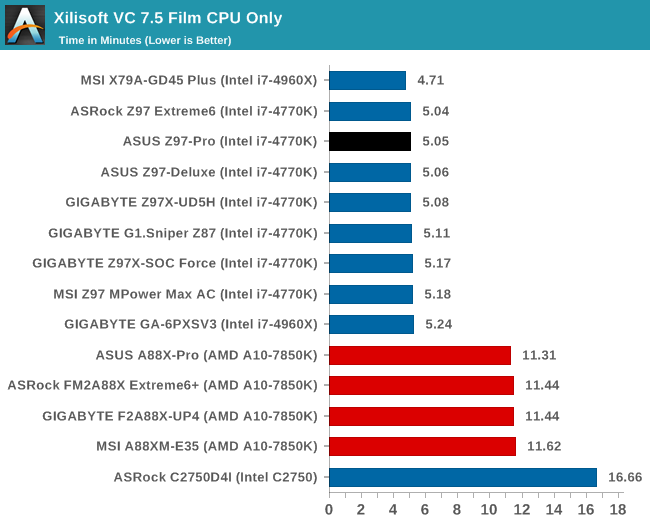

Video Conversion – Handbrake v0.9.9: link
Handbrake is a media conversion tool that was initially designed to help DVD ISOs and Video CDs into more common video formats. The principle today is still the same, primarily as an output for H.264 + AAC/MP3 audio within an MKV container. In our test we use the same videos as in the Xilisoft test, and results are given in frames per second.

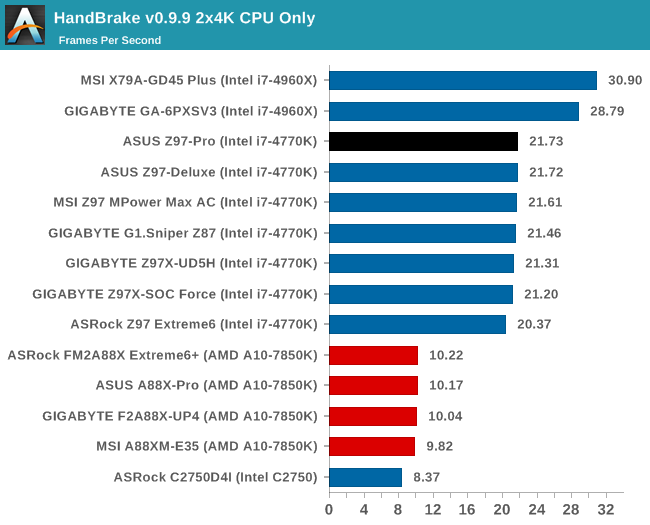
Rendering – PovRay 3.7: link
The Persistence of Vision RayTracer, or PovRay, is a freeware package for as the name suggests, ray tracing. It is a pure renderer, rather than modeling software, but the latest beta version contains a handy benchmark for stressing all processing threads on a platform. We have been using this test in motherboard reviews to test memory stability at various CPU speeds to good effect – if it passes the test, the IMC in the CPU is stable for a given CPU speed. As a CPU test, it runs for approximately 2-3 minutes on high end platforms.
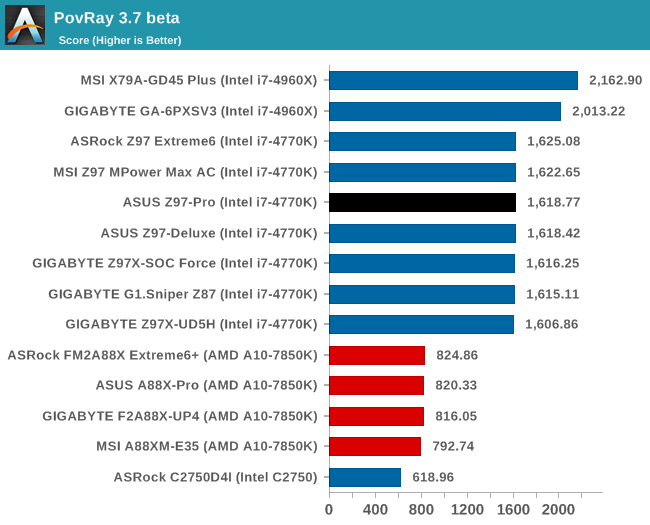
2D to 3D Rendering –Agisoft PhotoScan v1.0: link
Agisoft Photoscan creates 3D models from 2D images, a process which is very computationally expensive. The algorithm is split into four distinct phases, and different phases of the model reconstruction require either fast memory, fast IPC, more cores, or even OpenCL compute devices to hand. Agisoft supplied us with a special version of the software to script the process, where we take 50 images of a stately home and convert it into a medium quality model. This benchmark typically takes around 15-20 minutes on a high end PC on the CPU alone, with GPUs reducing the time.
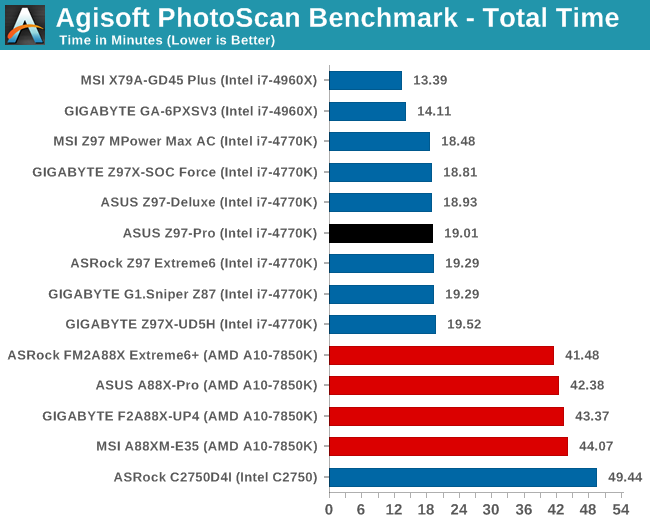
Console Emulation –Dolphin Benchmark: link
At the start of 2014 I was emailed with a link to a new emulation benchmark based on the Dolphin Emulator. The issue with emulators tends to be two-fold: game licensing and raw CPU power required for the emulation. As a result, many emulators are often bound by single thread CPU performance, and general reports tended to suggest that Haswell provided a significant boost to emulator performance. This benchmark runs a Wii program that raytraces a complex 3D scene inside the Dolphin Wii emulator. Performance on this benchmark is a good proxy of the speed of Dolphin CPU emulation, which is an intensive single core task using most aspects of a CPU. Results are given in minutes, where the Wii itself scores 17.53; meaning that anything above this is faster than an actual Wii for processing Wii code, albeit emulated.
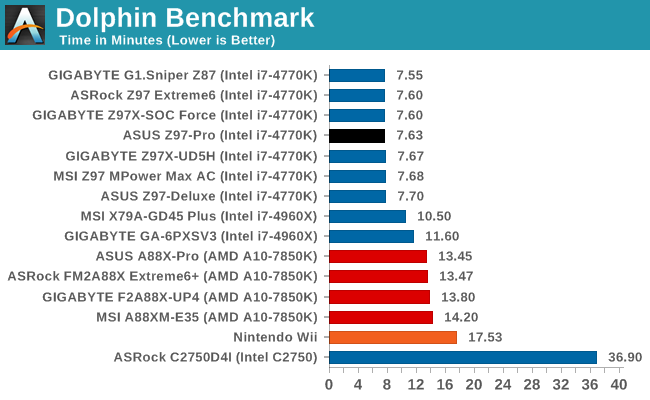
Point Calculations – 3D Movement Algorithm Test: link
3DPM is a self-penned benchmark, taking basic 3D movement algorithms used in Brownian Motion simulations and testing them for speed. High floating point performance, MHz and IPC wins in the single thread version, whereas the multithread version has to handle the threads and loves more cores.
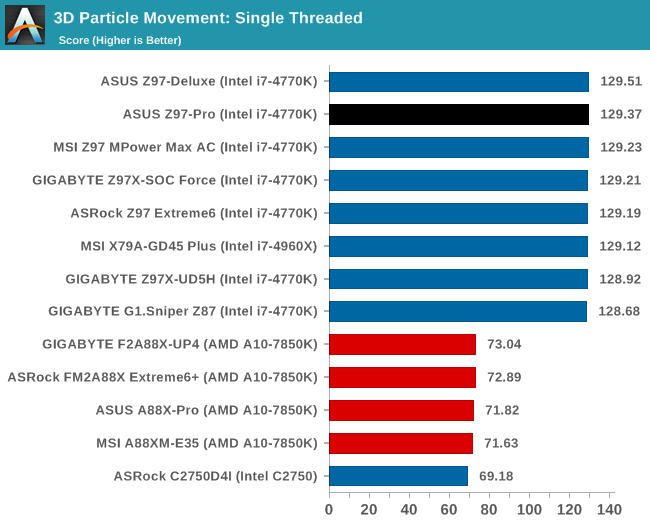
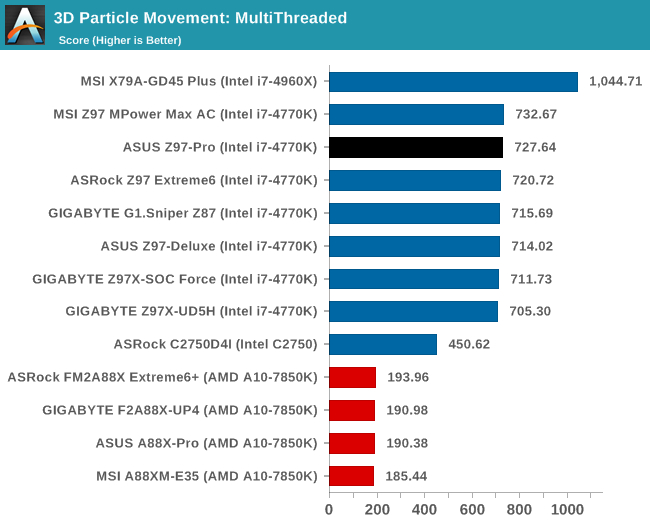
Synthetic – 7-Zip 9.2: link
As an open source compression tool, 7-Zip is a popular tool for making sets of files easier to handle and transfer. The software offers up its own benchmark, to which we report the result.
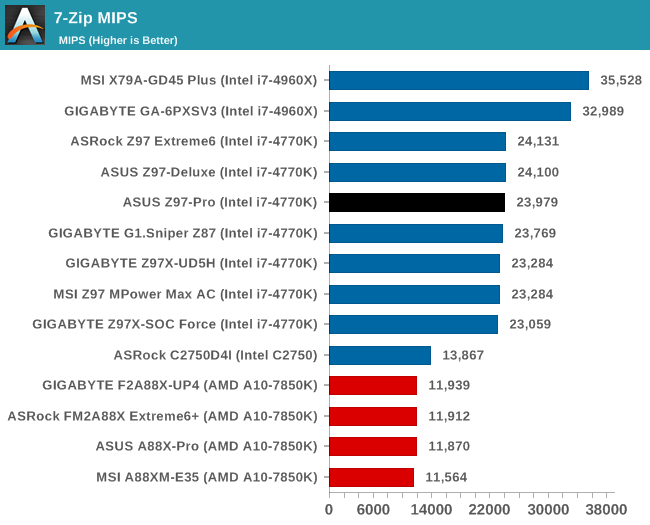










38 Comments
View All Comments
Samus - Wednesday, July 16, 2014 - link
I'm running a system based on the Asus Z97I-Plus (ITX) with a i5-4690K @ 4.5GHz 1.3v its been rock solid for the month I've had it.Coming from an Asus H81I ITX i5-4670K @ 4.2GHz. There are some mild BIOS improvements but the addition of M2 on the Z97I was what got me. That, and my H81 wouldn't run the Haswell refresh (chipset was old version) so I was pretty much locked into Haswell with no Broadwell/Skylake options for the future.
mapesdhs - Saturday, July 19, 2014 - link
Sounds good! I'm curious though, how are you cooling your 4690K? I've been pondering
whether a K CPU with a moderate oc is viable given I want minimum noise (for the HTPC
build that is).
Ian.
p1esk - Wednesday, July 16, 2014 - link
How could 2x580 be possibly quicker than Titan Black? It's 2x512 cores vs 2,880 cores at higher clock, and Titan has twice memory bandwidth.ZeDestructor - Thursday, July 17, 2014 - link
The cores perform differently. Similar to how clock for clock Haswell is faster than IVB. In this case, the 580 has more powerful, but slower and hotter cores than the titan black.By the looks of it, the blender code isn't memory bound either, which explains why it makes do with the lower bandwidth.
mapesdhs - Saturday, July 19, 2014 - link
As ZeDestructor says, the shader structure is very different in the 500 series, but to
clarify: after the 500 series, NVIDIA halved the shader clock speeds in order to make
power delivery & heat easier to deal with, but this means a lot more shaders are
required to give the same performance (almost 3X as many), eg. I've tested a K5000
which has 3X more shaders, but it's slower than a 580 for CUDA. This is why, for CUDA
tasks, a 580 beats all of the 600 series and most of the 700 series. Also, the 580 has a
lot of bandwidth, so the available bandwidth per core is very high compared to later
designs; this can make a difference in some cases.
See the following (for the Arion test, my system is no. 18 in the table; also note the table
has a typo, system 15 is a triple-780):
http://www.randomcontrol.com/arionbench
http://www.tomshardware.co.uk/forum/id-2173987/gig...
http://forums.creativecow.net/thread/2/1019120
A Titan Black does the Blender BMW/Cycles test in 24 seconds. My quad-580 system does
it in 11.56 seconds.
Summary: for CUDA, two 580s are quicker than a Titan, making them a good budget option
for AE users, etc., though of course it makes sense if possible to obtain 3GB models.
For 3D gaming though, the situation is completely different. Likewise, a CUDA task
requiring mostly FP64 would be better with Titans.
Ian.
FriendlyUser - Wednesday, July 16, 2014 - link
I particularly appreciate the Intel 218V Lan. An excellent choice. Together with the decent onboard audio, you really get some premium hardware for your money. I don't particularly care for the Wi-Fi AC controller, though. These things change so fast, I'd rather have an expansion card (for example, the 802.11ac spec could theoretically scale up to several Gbs). Plus, I prefer getting WiFi equipment from the same vendor, to simplify installation and interoperability.DanNeely - Wednesday, July 16, 2014 - link
I'm ambivalent about the wifi, since I'd only ever use it as a temporary backup option.What annoys me a bit is that it looks like the connector is a PCIe 1x slot that was moved closer to the back edge of the board. If they wanted to play fast and loose with the standard to get wifi out in the IO port area instead of the expansion card area; if they'd put the adapter where the audio out is and at the standard distance from the edge it would be possible to kludge an off the shelf card in as an upgrade by removing it's bracket and either removing the IO shield or trimming it out with a cutting tool.
ZeDestructor - Thursday, July 17, 2014 - link
What's even more annoying is that they're not using a standard miniPCIe or M.2 wifi card instead with some internal U.Fl to RP-SMA coax cabling from somewhere else (right behind the PCIe 1x slots comes to mind) on the board.Btw, it seems thay are using something that's more than PCIe x1 but less than PCIe x4.. nice and proprietary.
Antronman - Wednesday, July 16, 2014 - link
Not even Asus' top end, and it already blows away the competition...Samus - Wednesday, July 16, 2014 - link
Yeah I'm surprised what a value it actually is. Sub-$200 and you get Intel Gigabit, Xonar-class audio, M.2, VRM heatsinks and all the typical Z97 stuff. I also like the 90-series motherboard color schemes. They're actually reminiscent of ASRock's. The 80-series Asus boards had a weird color combo (yellow DIMM slots, for example) but ASRock had this Black/Gold theme.And I don't care what people say, I've had Asus boards since the i486 days and every single one has been incredibly solid.